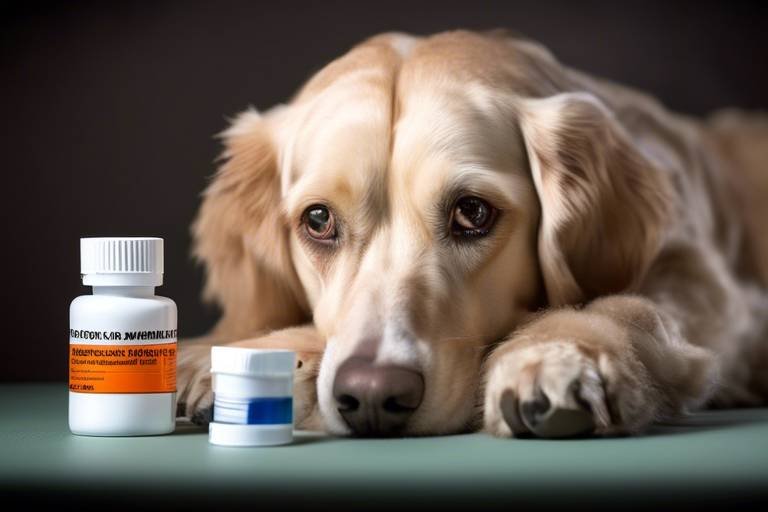How to Administer Medication to Your Pet in Emergencies
When it comes to our furry friends, nothing is more important than their health and well-being. Emergencies can strike at any moment, and being prepared to administer medication can be the difference between life and death. Imagine your beloved pet suddenly falling ill or getting injured; panic can easily set in. But, if you have the right knowledge and tools at your disposal, you can act swiftly and efficiently. This article provides essential guidance on effectively administering medication to pets during emergencies, ensuring their safety and well-being in critical situations. Understanding the right techniques can make a significant difference.
Before diving into the nitty-gritty of administering medication, it's crucial to understand what types of medications your pet might need. Pet medications can range from pain relievers to antibiotics, each serving a unique purpose. For instance, pain medications help alleviate discomfort, while antibiotics combat infections. Additionally, medications come in various forms, such as pills, liquids, and topical treatments. Knowing the potential side effects is equally important; after all, you wouldn’t want to accidentally worsen your pet's condition. Always consult your veterinarian for detailed information on the medications prescribed to your pet, as this knowledge is vital for making informed decisions during emergencies.
Preparation is key in emergency situations. Just like you wouldn’t head into a storm without an umbrella, you shouldn't face a pet emergency unprepared. Discover essential steps to take before an emergency arises, including assembling a pet first aid kit and familiarizing yourself with your pet’s medical history. A well-prepared pet owner is an empowered pet owner, and that empowerment can lead to quicker response times and better outcomes in critical situations.
A well-stocked first aid kit can be a lifesaver. Imagine having everything you need right at your fingertips during a crisis. Explore the essential items to include, such as bandages, antiseptics, and a copy of your pet’s medication instructions. Having these items organized and easily accessible can save precious minutes when every second counts. Here’s a quick overview of what to include in your kit:
| Item | Purpose |
|---|---|
| Bandages | To cover wounds and prevent infection |
| Antiseptic | To clean wounds and reduce the risk of infection |
| Gauze Pads | For absorbing fluids and covering larger wounds |
| Thermometer | To check for fever |
| Medication Instructions | To ensure proper dosage and administration |
Certain medications should always be on hand. Think of these as your pet's safety net during emergencies. Learn which over-the-counter and prescription medications are vital for your pet's health, and how to store them properly. Common medications include:
- Antihistamines: Useful for allergic reactions.
- Pain relievers: Such as aspirin (consult your vet first).
- Activated charcoal: For poisoning scenarios.
The right tools can simplify the process of administering medication. Imagine trying to cut a steak with a butter knife; it just won’t work! Understanding which syringes, droppers, and pill poppers can aid in delivering medication effectively and safely is essential. For instance, a syringe can help you measure liquid medications accurately, while a pill popper can make giving pills a breeze.
Being able to identify when your pet is in distress is crucial. Familiarize yourself with common signs of pain or illness that may require immediate medication intervention. These signs can include excessive whining, panting, or even hiding. If your pet is acting out of character, don’t brush it off; it could be a signal that something is wrong.
Oral medications can be tricky to give. Think of it like trying to convince a toddler to eat their vegetables; it requires patience and creativity! Discover techniques for successfully administering pills or liquids, including tips for making the process easier for both you and your pet. The goal is to make the experience as stress-free as possible.
Learn effective methods for giving pills, such as hiding them in food or using a pill pocket. These techniques can reduce stress for both you and your pet. For example, wrapping the pill in a small piece of cheese can work wonders. Just make sure your pet swallows it whole!
Administering liquid medication can pose its own challenges. It’s like trying to pour a drink without spilling; it requires a steady hand! Discover strategies for ensuring your pet receives the full dose without resistance or distress. Using a syringe to squirt the medication into the side of their mouth can help, as it allows for better control and reduces the chance of choking.
Not all emergencies can be managed at home. It's essential to recognize when it’s critical to contact a veterinarian or an emergency clinic for professional assistance and guidance. If your pet is experiencing severe symptoms like difficulty breathing, seizures, or unresponsiveness, don’t hesitate to seek help. Trust your instincts; they are often your best guide in a crisis.
Q: How do I know if my pet needs medication?
A: Look for signs of distress, unusual behavior, or symptoms like vomiting, diarrhea, or lethargy. If in doubt, consult your vet.
Q: Can I administer human medication to my pet?
A: Not without consulting your veterinarian first! Some human medications can be toxic to pets.
Q: What should I do if my pet refuses to take their medication?
A: Try hiding the medication in a treat or using a pill pocket. If that fails, consult your vet for alternative options.

Understanding Pet Medications
When it comes to our furry friends, understanding pet medications is absolutely crucial. Just like humans, pets can suffer from a variety of health issues that require medication for treatment. These medications can range from prescription drugs to over-the-counter remedies, and knowing how to use them safely can make all the difference in an emergency.
First off, let’s break down the different types of medications available for pets. These can generally be categorized into several groups:
- Antibiotics: Used to fight bacterial infections.
- Analgesics: Pain relievers that help alleviate discomfort.
- Anti-inflammatory drugs: Reduce swelling and inflammation.
- Antiparasitics: Medications that eliminate parasites like fleas, ticks, and worms.
- Vaccines: Prevent diseases by building immunity.
Each of these medications serves a specific purpose, and understanding what they do can help you make informed decisions during emergencies. For instance, if your pet has an allergic reaction, knowing that an antihistamine is suitable can save precious time. However, it’s also vital to be aware of the potential side effects that can accompany these medications. Some common side effects include:
| Medication Type | Common Side Effects |
|---|---|
| Antibiotics | Vomiting, diarrhea, loss of appetite |
| Pain Relievers | Gastrointestinal upset, lethargy |
| Anti-inflammatories | Kidney or liver issues, stomach ulcers |
It’s also essential to recognize that some medications that are safe for humans can be toxic to pets. For example, ibuprofen and acetaminophen are common pain relievers for humans but can be deadly to dogs and cats. Always consult with your veterinarian before administering any medication that wasn’t specifically prescribed for your pet.
In addition to knowing the types of medications, it’s equally important to understand their forms. Medications can come in various forms, including tablets, liquids, and topical applications. Each form has its own method of administration, and some pets may be more receptive to certain forms than others. For example, a cat might refuse to take a pill but might readily accept liquid medication mixed into their food. This is where your knowledge of your pet’s preferences plays a vital role.
Lastly, keeping a record of your pet’s medications is a smart practice. You should have a list that includes:
- The name of the medication
- The prescribed dosage
- Frequency of administration
- Any specific instructions from your veterinarian
By being well-informed about pet medications, you can ensure that you’re prepared to act swiftly and effectively in emergencies. Remember, the safety and well-being of your pet depend on your knowledge and preparedness!
Q: What should I do if I accidentally give my pet the wrong medication?
A: Contact your veterinarian or an emergency animal clinic immediately for guidance. They may instruct you to bring your pet in for treatment.
Q: Can I give my pet human medications?
A: It’s best to avoid this unless your veterinarian specifically advises it. Many human medications are toxic to pets.
Q: How can I make my pet more comfortable with taking medication?
A: Try hiding pills in treats or using flavored liquid medications. Be patient, and always reward your pet after they take their medication.

Preparing for an Emergency
When it comes to our beloved pets, **preparation** is not just a good idea; it's essential. Emergencies can strike at any moment, and being ready can mean the difference between life and death. Imagine your furry friend suddenly falling ill or getting injured. Wouldn't you want to be equipped with the right tools and knowledge to help them? Understanding the necessary steps to prepare for an emergency can give you peace of mind and ensure your pet's safety.
First, consider assembling a comprehensive **pet first aid kit**. This kit should be tailored specifically for your pet's needs and should contain various items that can assist in different emergency scenarios. Think of it as your pet's safety backpack! Essential items to include are:
- Bandages and gauze
- Antiseptic wipes or solution
- Thermometer
- Tweezers for splinter removal
- A muzzle (for safety during handling)
- Copies of your pet's medical records and medication instructions
It's also vital to familiarize yourself with your pet's **medical history**. Knowing their past illnesses, allergies, and current medications can help you make informed decisions during an emergency. Keep a copy of their medical records in your first aid kit, so you have it handy when you need it the most.
Consider also creating a **contact list** for emergencies. This list should include your veterinarian's phone number, the nearest emergency animal clinic, and any pet poison control hotline numbers. You never know when you might need to reach out for professional help, and having these contacts readily available can save precious time.
Lastly, practice makes perfect! Just like you wouldn’t wait until a fire breaks out to learn how to use a fire extinguisher, you shouldn’t wait for an emergency to familiarize yourself with your pet's first aid kit. Take some time to go through the items, understand their uses, and even practice basic first aid techniques. This preparation can empower you to act quickly and confidently when it matters most.
Q: What should I include in my pet's first aid kit?
A: Essential items include bandages, antiseptic wipes, a thermometer, tweezers, and copies of your pet's medical records.
Q: How can I familiarize myself with my pet's medical history?
A: Keep a record of their past illnesses, allergies, and current medications in your first aid kit for easy access during emergencies.
Q: When should I seek professional help for my pet?
A: If your pet shows severe symptoms, such as difficulty breathing, excessive bleeding, or unresponsiveness, contact your veterinarian or an emergency clinic immediately.
Creating a Pet First Aid Kit
When it comes to our furry friends, being prepared for an emergency is not just wise—it's essential. A well-stocked pet first aid kit can be your best ally in a crisis, providing you with the tools and supplies needed to address minor injuries or stabilize your pet until professional help is available. But what exactly should you include in this kit? Let's break it down.
First and foremost, consider the basic supplies that every first aid kit should have. These items will help you manage common injuries like cuts, scrapes, or even allergic reactions. Here’s a brief list of essentials:
- Adhesive bandages in various sizes
- Gauze pads and rolls
- Medical tape
- Antiseptic wipes or solution
- Tweezers for removing splinters or ticks
- Scissors to cut bandages or tape
In addition to these basics, having medications on hand can make a significant difference. Always consult your veterinarian about which medications are appropriate for your pet, but commonly recommended items include:
- Antihistamines for allergic reactions
- Activated charcoal for poisoning cases (under vet guidance)
- Flea and tick prevention treatments
Don't forget to include a copy of your pet’s medical history, including any current medications and allergies. This information can be invaluable in an emergency. You might also want to add a list of emergency contacts, including your vet’s number and the nearest animal emergency clinic. Having this information easily accessible can save precious time when every second counts.
Now, let’s talk about storage. A first aid kit is only effective if you know where it is and can access it quickly. Choose a sturdy, waterproof container that can be easily transported. Make sure to check the kit regularly and replace any expired medications or supplies. It’s also a good idea to familiarize yourself with the contents of the kit so that you can act swiftly in an emergency.
Ultimately, creating a pet first aid kit is about ensuring the safety and well-being of your beloved companion. It’s a small investment that can lead to significant peace of mind, knowing you’re prepared for the unexpected. Remember, the goal is to stabilize your pet until you can get them to a veterinarian, so having the right tools at your disposal is crucial.
Essential Medications to Include
When it comes to your furry friend’s health, being prepared is half the battle. Having a selection of essential medications on hand can mean the difference between a minor mishap and a serious emergency. It's important to stock your pet first aid kit with medications that can address common ailments and emergencies. Here are some vital medications you should consider including:
- Antihistamines: These can be lifesavers for pets suffering from allergic reactions. Always consult your vet for the correct dosage and type, as some antihistamines can be toxic to pets.
- Activated Charcoal: This is useful for cases of poisoning, as it can help absorb toxins. However, it should only be administered under veterinary guidance.
- Anti-inflammatory Medications: Non-steroidal anti-inflammatory drugs (NSAIDs) can help relieve pain and swelling. Again, ensure you’re using vet-approved options, as human medications can be harmful to pets.
- Antibiotics: Having a broad-spectrum antibiotic can be crucial for treating minor infections, but these should only be used when prescribed by a veterinarian.
- Topical Ointments: These can help with minor cuts and abrasions. Look for pet-safe options that promote healing without the risk of toxicity.
In addition to these medications, it's also wise to keep a copy of your pet's medication instructions and any prescriptions from your veterinarian. This ensures that, in the heat of the moment, you can quickly reference the correct dosages and administration methods. Remember, medications should be stored in a cool, dry place, away from direct sunlight, and out of reach of curious paws. Regularly check the expiration dates and replace any expired items to keep your kit up to date.
Ultimately, being prepared with the right medications can provide peace of mind and improve your pet's chances of recovery in emergencies. Knowledge is power, and understanding how to use these medications effectively will make you a more confident pet owner when the unexpected occurs.
Tools for Administration
Administering medication to your pet can feel like a daunting task, especially when you're in a hurry or your furry friend is feeling unwell. However, having the right tools at your disposal can make this process much easier and less stressful for both you and your pet. Think of these tools as your trusty sidekicks in the battle for your pet's health!
First on the list is the syringe. A syringe is incredibly useful for delivering liquid medications, as it allows you to measure the exact dose required. It's crucial to use a syringe without a needle, as this ensures safety while administering the medication. When using a syringe, aim for the side of your pet's mouth, and gently squirt the medication in. This method minimizes the chance of choking and makes it easier for your pet to swallow.
Next up, we have the dropper. Similar to a syringe, a dropper is perfect for liquid medications, especially those that are thicker or require a more controlled application. It's essential to hold your pet's head steady and place the dropper in the side of their mouth, allowing the liquid to flow in slowly. This method not only helps in avoiding spillage but also makes it more palatable for your pet.
For those stubborn pills that your pet just refuses to take, a pill popper can be a game-changer. This handy tool allows you to place the pill at the back of your pet's throat without putting your fingers at risk of being bitten. Just load the pill into the device, gently open your pet's mouth, and push the plunger to release the pill. It’s quick, efficient, and can save you from a lot of stress!
In addition to these tools, it’s also beneficial to have some pill pockets on hand. These are specially designed treats that have a pocket for hiding pills. They can turn the dreaded medication time into a treat time, making it much easier for your pet to take their medicine without any fuss. Just remember to choose a flavor your pet loves!
Lastly, always keep a copy of your pet’s medication instructions and health records in your first aid kit. This documentation can be invaluable in ensuring that you administer the correct dosage and understand any potential side effects. You can create a simple table to keep track of this information:
| Medication Name | Dosage | Frequency | Notes |
|---|---|---|---|
| Example Medication 1 | 10 mg | Twice a day | Administer with food |
| Example Medication 2 | 5 ml | Once a day | Shake well before use |
Having these tools and resources at your disposal can make administering medication to your pet a smoother experience. Remember, the goal is to keep your pet safe and healthy, and with a little preparation and the right tools, you can handle any emergency with confidence!
- What should I do if my pet refuses to take their medication? Try using pill pockets or disguising the medication in their favorite food. If that fails, consult your vet for alternative options.
- How can I tell if my pet is having a bad reaction to medication? Look for signs like excessive drooling, vomiting, or lethargy. If you notice any of these symptoms, contact your veterinarian immediately.
- Can I crush my pet's pills to make them easier to administer? Some medications can be crushed, while others cannot. Always check with your veterinarian before altering the form of the medication.
Recognizing Signs of Distress
When it comes to our furry friends, being able to recognize the signs of distress is crucial. Just like humans, pets can’t always vocalize their discomfort, so it’s up to us to be their advocates. Have you ever noticed your pet acting differently? Maybe they’re hiding under the bed or refusing to eat their favorite treat. These subtle changes can often indicate that something is amiss. Understanding these signs can help you respond quickly in an emergency.
Pets can exhibit a range of behaviors when they’re in pain or feeling unwell. Here are some common signs to watch for:
- Changes in Appetite: If your pet suddenly loses interest in food or water, it could be a sign of distress.
- Excessive Vocalization: Uncharacteristic barking, whining, or meowing can indicate discomfort.
- Behavioral Changes: If your usually playful pet becomes lethargic or withdrawn, it’s time to pay attention.
- Physical Symptoms: Look for signs like limping, swelling, or unusual breathing patterns.
It’s also important to note that some pets may react differently based on their personality. For instance, a typically calm dog might become aggressive when in pain, while a shy cat may retreat even further. This variability makes it essential to know your pet's normal behavior so you can spot any changes quickly.
In addition to these behavioral cues, you might observe physical signs such as:
| Physical Sign | Possible Issue |
|---|---|
| Shaking or Trembling | Pain, anxiety, or illness |
| Excessive Grooming | Stress or skin issues |
| Vomiting or Diarrhea | Digestive issues or poisoning |
Being observant and proactive can make a world of difference when it comes to your pet's health. If you notice any of these signs, don’t hesitate to take action. Sometimes, a quick call to your veterinarian can provide you with the guidance you need to determine the best course of action. After all, your pet relies on you to keep them safe and healthy!
Q: What should I do if my pet shows signs of distress?
A: If your pet displays signs of distress, first assess the situation and try to determine the cause. If it seems serious or if you're unsure, contact your veterinarian or an emergency clinic immediately.
Q: How can I prepare for an emergency involving my pet?
A: Familiarize yourself with your pet’s medical history, keep a well-stocked first aid kit, and know the signs of distress to act quickly when needed.
Q: Are there specific medications I should have on hand for emergencies?
A: Yes, certain over-the-counter and prescription medications can be vital. Consult your veterinarian to know what’s appropriate for your pet.

Administering Oral Medications
Administering oral medications to pets can often feel like trying to convince a toddler to eat their vegetables—it's not always easy! However, with the right techniques and a bit of patience, you can make this process smoother for both you and your furry friend. First, it’s essential to understand that some pets may resist taking medication due to its taste or the method of delivery. This is why knowing a variety of techniques can be incredibly beneficial.
One of the most effective methods for giving pills is to hide them in food. Many pet owners have had success with this approach. You could use a small amount of peanut butter, cheese, or a favorite treat to mask the taste of the medication. Just ensure that the food is safe for your pet to consume. If your pet is particularly savvy and manages to separate the medication from the food, consider using a pill pocket. These are specially designed treats that have a pocket to hold the pill, making it more enticing and less suspicious.
However, if your pet refuses to take the medication hidden in food, you might need to resort to a more direct approach. Here’s where the pilling technique comes into play. Start by gently holding your pet’s head from above, tilting it back slightly. Using your other hand, place the pill as far back on the tongue as possible, then close their mouth and gently stroke their throat to encourage swallowing. This method can take some practice, but it’s often effective.
For liquid medications, the approach can be slightly different. Many pets dislike the taste of liquid medicine, which can lead to a messy battle. To administer liquid medication, hold your pet securely and use a syringe or dropper to place the liquid between their cheek and gums. This method allows the liquid to flow into their mouth without overwhelming them. Remember to reward your pet with praise or a treat afterward to create a positive association with the experience.
It’s important to note that timing is everything. Administer medications at the same time each day, if possible, to create a routine. This consistency can help your pet become more accustomed to taking their medication. Also, always follow the veterinarian's instructions regarding dosage and frequency. If you’re ever unsure about how to administer a specific medication, don’t hesitate to reach out to your vet for guidance.
In summary, administering oral medications to your pet doesn’t have to be a daunting task. With a little creativity and patience, you can find the method that works best for your furry companion. Remember, the goal is not just to get the medication into your pet but to do so in a way that minimizes stress for both of you.
- What should I do if my pet refuses to take their medication? Try hiding the medication in a favorite treat or using a pill pocket. If they still refuse, consult your veterinarian for alternative options.
- Can I crush pills to make them easier to give? Some medications can be crushed, but others cannot. Always check with your vet before altering the form of any medication.
- How can I tell if my pet has swallowed the medication? Look for signs such as licking their lips or swallowing. You can also check their mouth to see if the pill is still there.
Pill Administration Techniques
Administering pills to your pet can often feel like trying to convince a cat to take a bath—it's not easy! However, with the right techniques and a little bit of patience, you can make the process smoother for both you and your furry friend. The key is to approach the situation calmly and confidently, as pets can pick up on your anxiety. One effective method is to hide the pill in a small amount of your pet’s favorite food. This could be a piece of cheese, peanut butter, or even a special treat. Just be sure to monitor the amount of food you use, as you don’t want to overwhelm them with too much.
If your pet is particularly savvy and manages to pick the pill out of their food, you might want to consider using a pill pocket. These are soft, chewy treats designed specifically to hold pills, making it a lot easier for your pet to swallow them without realizing it. You can find these at most pet supply stores, and they come in various flavors to appeal to different tastes.
For pets that are more challenging to administer pills to, you may need to resort to the direct method. First, ensure you have a firm but gentle grip on your pet to prevent sudden movements. It can be helpful to have someone assist you by holding the pet still. Gently tilt your pet’s head back, which can help open their mouth slightly. Use your other hand to place the pill as far back on the tongue as possible. This may require a bit of practice, so don't be discouraged if it doesn’t go perfectly the first time. After placing the pill, close your pet’s mouth and gently rub their throat to encourage swallowing.
Remember, some pets might gag or spit out the pill, so it's crucial to stay calm. If this happens, don’t punish your pet; instead, try again. You can also follow up with a small amount of water using a syringe (without the needle) to help wash the pill down, but ensure your pet is comfortable with this method first.
In cases where your pet absolutely refuses to take pills, consult your veterinarian. They can provide alternative forms of medication such as flavored liquids or even injections that may be more suitable for your pet’s needs.
Ultimately, the goal is to ensure that your pet receives their medication without added stress. With practice and the right techniques, you’ll become a pro at administering pills in no time!
- What should I do if my pet refuses to take the pill? If your pet refuses the pill, try disguising it in food or using a pill pocket. If that fails, consult your veterinarian for alternative medication options.
- Can I crush the pill and mix it with food? Some pills can be crushed, but not all. Always check with your veterinarian first, as crushing certain medications can alter their effectiveness.
- How can I tell if my pet has swallowed the pill? Watch for signs like licking their lips, swallowing motions, or looking for more food. If you're unsure, offer a small treat afterward to see if they accept it.
Liquid Medication Tips
Administering liquid medication to your pet can sometimes feel like trying to give a cat a bath—challenging and messy! However, with the right approach, you can make this process smoother and less stressful for both you and your furry friend. First and foremost, it's important to stay calm. Animals are incredibly perceptive and can pick up on your anxiety, which may lead to their own stress. So, take a deep breath and get ready to tackle this task!
One effective strategy for administering liquid medication is to use a syringe or dropper. This method allows for precise dosing and minimizes spillage. Here’s how to do it:
- Prepare the Syringe: Fill the syringe with the prescribed amount of medication. Make sure to eliminate any air bubbles by pulling the plunger back slightly and then pushing it forward until the liquid flows smoothly.
- Position Your Pet: Gently hold your pet in a comfortable position. If they’re small, cradling them in your lap or on a soft surface can help. For larger pets, having someone assist you can be beneficial.
- Administering the Medication: Place the syringe or dropper at the side of your pet’s mouth, aiming for the back of the throat. This helps avoid the gag reflex. Slowly squirt the medication into their mouth, allowing them to swallow naturally.
Another tip is to mask the taste. Some medications have a strong flavor that might deter your pet from taking them. You can try mixing the medication with a small amount of their favorite wet food or a treat designed for pill hiding. Just be sure to check with your veterinarian that this is safe for the specific medication you’re administering.
If your pet is particularly resistant, consider using a compounding pharmacy. These specialized pharmacies can create flavored versions of medications that are more palatable for pets. This can be a game changer, especially for those finicky eaters!
Lastly, always follow up with a reward. After successfully administering the medication, give your pet a treat or some extra affection. This positive reinforcement will help them associate medication time with something pleasant, making future doses easier.
Remember, patience is key! If your pet struggles, don’t force it; take a break and try again later. With practice and the right techniques, you’ll become a pro at administering liquid medication, ensuring your pet gets the care they need.
Q: What should I do if my pet refuses to take liquid medication?
A: If your pet refuses the medication, try mixing it with a small amount of their favorite food or consult your veterinarian for alternative methods or formulations.
Q: Can I use human syringes to give my pet medication?
A: Yes, as long as the syringes are clean and used solely for administering pet medications, they can be effective tools for this purpose.
Q: How can I tell if my pet has swallowed the medication?
A: Watch for signs of swallowing, such as licking their lips or shaking their head. You can also check the syringe for remaining liquid to confirm they took the full dose.

When to Seek Professional Help
In the world of pet care, there are moments when your best friend needs more than just your love and attention. While it’s essential to feel empowered to handle minor emergencies at home, there are critical situations where seeking professional help is not just advisable but necessary. Knowing when to pick up the phone and call your veterinarian or an emergency clinic can make all the difference for your pet's health and well-being.
First and foremost, if your pet exhibits any signs of severe distress, it’s time to act. Signs such as persistent vomiting, diarrhea, or unresponsiveness could indicate a serious condition that requires immediate medical attention. Remember, just like humans, pets can experience sudden health crises that require urgent care. If you notice your pet is breathing heavily or has difficulty standing, don’t hesitate to seek help.
Another critical factor to consider is the type of medication your pet has ingested. If your furry friend has accidentally swallowed something they shouldn't have, such as human medication or toxic substances like chocolate or certain plants, it's imperative to contact a veterinarian immediately. In such cases, time is of the essence, and the sooner you act, the better the chances of a positive outcome.
Additionally, if your pet has a pre-existing medical condition, such as diabetes or heart disease, any sudden changes in their behavior or health should be treated with caution. For instance, if your diabetic pet becomes lethargic or refuses to eat, this could signify an insulin imbalance that requires professional intervention. It’s always better to err on the side of caution when it comes to your pet’s health.
Here are some specific scenarios when you should definitely seek professional help:
- Severe injury: If your pet has been in an accident or has a deep wound, immediate veterinary care is essential.
- Difficulty breathing: Struggling to breathe can be a sign of a serious issue, such as an allergic reaction or respiratory distress.
- Seizures: If your pet experiences a seizure, it’s crucial to get them to a vet as soon as possible.
- Signs of pain: If your pet is vocalizing or showing signs of discomfort, such as hiding or excessive grooming, it’s time to consult a professional.
Ultimately, your intuition as a pet owner plays a significant role in determining when to seek help. If something feels off, trust your instincts. It’s always better to be safe than sorry, and your veterinarian can provide the necessary guidance and reassurance. They can help you assess the situation and determine the best course of action, whether it’s a simple consultation or an urgent visit to their clinic.
In conclusion, while being prepared and knowledgeable about administering medication is incredibly valuable, knowing when to seek professional help is equally important. Your pet relies on you for their care, and being proactive can prevent small issues from escalating into bigger problems. So, keep your vet's number handy, and don’t hesitate to reach out when in doubt. After all, your pet deserves the best care possible!
Here are some common queries pet owners have regarding emergency situations and seeking professional help:
- What should I do if my pet ingests something toxic? - Call your veterinarian or an emergency animal poison control hotline immediately.
- How can I tell if my pet is in pain? - Look for signs such as whining, hiding, changes in appetite, or reluctance to move.
- Is it okay to wait and see if my pet improves? - If you notice any concerning symptoms, it’s best to seek help right away rather than wait.
- What information should I provide to the vet during an emergency? - Be ready to share your pet's medical history, any medications they are currently taking, and a description of the symptoms.
Frequently Asked Questions
- What should I include in a pet first aid kit?
When preparing a pet first aid kit, make sure to include essential items like bandages, antiseptics, gauze, scissors, tweezers, and a digital thermometer. Additionally, having a copy of your pet's medical history and current medications can be incredibly helpful in emergencies.
- How can I tell if my pet is in distress?
Look for signs such as excessive barking, whining, panting, or hiding. Physical symptoms can include limping, swelling, or changes in appetite. If you notice any of these signs, it’s crucial to assess the situation and determine if medication or a trip to the vet is necessary.
- What are some effective techniques for administering pills to my pet?
There are several techniques you can try! Hiding the pill in a small amount of food, like peanut butter or cheese, can often do the trick. You can also use pill pockets specifically designed for this purpose. If your pet is still resistant, using a pill popper can help you deliver the medication safely.
- How do I administer liquid medication to my pet?
Administering liquid medication can be a bit challenging. Use a syringe or dropper to place the medication in the side of your pet's mouth, aiming for the back of the throat. This can help ensure they swallow it. Make sure to reward them afterward to create a positive association!
- When should I seek professional help for my pet?
If your pet shows severe signs of distress, such as difficulty breathing, unresponsiveness, or persistent vomiting, it’s critical to contact a veterinarian or emergency clinic immediately. Trust your instincts—if something feels off, it’s always better to be safe than sorry!
- Can I use human medications for my pet?
Not all human medications are safe for pets! Some can be toxic or cause serious side effects. Always consult with your veterinarian before giving any medication to your pet, even if it’s something you think might help.



















